|
Designing and Implementing Virtual Courseware to
Promote
Inquiry-based Learning
Robert A. Desharnais
Professor, Department of Biological Sciences
and Director, Virtual Courseware Project
California State University, Los Angeles
Los Angeles, CA 90032-8201
USA
rdeshar@calstatela.edu
Melvin Limson
K-12 Education Programs Coordinator
American Physiological Society
Bethesda, MD 20814-3991
USA
mlimson@the-aps.org
Abstract
Web-based learning objects continue to evolve as
technological advances enhance our ability to create and
share high-quality learning resources. An important class
of learning objects are simulations intended to supplement
traditional science instruction. After several years of
experience in this endeavor, the Virtual Courseware
Project has arrived at a set of ten design principles that
it uses to guide its development of new web-based learning
activities. These guiding principles place an emphasis on
educational standards, open-ended inquiry-based learning,
scientific methodology, critical thinking, and an
intuitive and interactive user interface that includes
linear tours, assessment tools, and documentation. These
design principles are exemplified in Drosophila, an
activity for learning the genetics of inheritance.
Keywords:
inquiry-based learning, learning object design, science
simulations, Virtual Courseware, web-based learning
objects
Introduction
Science instructors seek engaging,
effective, and inquiry-based activities that are
convenient to implement in their classrooms (Flick and
Bell, 2000; National Research Council, 2000). While the
Web provides a vast resource of declarative information
(some of it multimedia), far less common are Web sites
where instructors can obtain effective inquiry-based tools
for teaching science.
The Virtual
Courseware Project at California State University, Los
Angeles addresses this need through the development and
implementation of interactive, web-based simulation
activities that emphasize the scientific methods of
inquiry: making observations, formulating hypotheses,
designing experiments, collecting and analyzing data, and
arriving at conclusions based on these analyses. By
augmenting traditional instruction with simulations,
science educators provide a more engaging learning
experience that emphasizes science as a process rather
than a collection of knowledge to be assimilated (Linn,
Davis, and Bell, 2004).
The creation of effective
inquiry-based learning objects requires careful thought
and planning (Edelson, Gordin, and Pea, 1999). The
purpose of this paper is to outline a set of design
principles that can be used in the development of “Virtual
Courseware” and to provide an example of how these
principles have been implemented in the Virtual Courseware
Project simulations. The next section provides a brief
history of the Virtual Courseware Project which began in
the late 1980’s. The following section summarizes the
design principles that have developed from nearly twenty
years of experience in the creation of educational
software. This is followed by a description of the most
recently developed Virtual Courseware activity that
exhibits these design principles. The paper ends with a
brief conclusion.
Historical Background of the
Virtual Courseware Project
The Virtual Courseware
Project
has its beginning in 1988 when Apple CEO Steve Jobs
introduced his groundbreaking NeXT computers for higher
education. (For an overview of NeXT and additional
references, go to
http://en.wikipedia.org/wiki/NeXT.) Over the next
several years California State University at Los Angeles
established a computer classroom of 20 NeXT workstations
and developed a variety of NeXTSTEP applications for use
in science classes. These activities were supported by
three major grants from the National Science Foundation
(NSF) with matching funds from the California State
University (CSU). These applications were disseminated
freely over the web and were used by most institutions of
higher education with significant NeXT computer
installations.
In
the early 1990’s the emergence of the World-Wide-Web
provided a new opportunity for the use and dissemination
of instructional technology. In 1995 a NeXTSTEP
application called FlyLab was converted into a web-based
simulation called Virtual FlyLab. Soon after its release
in June 1995, it became a popular tool for genetics
instructors worldwide, with over 665,000 students using
Virtual FlyLab to conduct over 5 million genetic crosses.
In June of 1996 the release of Virtual Earthquake was met
with similar success with over 1.5 million “certificates
of completion” issued to date. It was clear there was a
large demand for inquiry-based science education
activities and that the Web was an effective means of
dissemination.
The success of Virtual FlyLab
led to development of Biology Labs On-Line (BiologyLabsOnLine.com),
a commercial partnership between the CSU Center for
Distributed Learning and the publisher Benjamin Cummings.
This subscription web site offers 12 biology simulations
on a variety of topics for a modest price
($5.25/year/applet). Since its availability in 2002,
students have purchased over 500,000 applet subscriptions.
Hundreds of colleges and universities use these learning
tools.
These initial efforts
blossomed into the “Virtual Courseware Project”
(ScienceCourseware.org).
Two suites of activities have been developed and released.
Geology Labs On-Line contains the activities Virtual
Earthquake, Virtual Dating, and Virtual River. The second
subproject, Virtual Courseware for Earth and Environmental
Sciences consists of Earthquake and Global Warming. The
latter subproject includes assessment tools for
instructors who register their classes. Students are
presented with a randomized quiz and the results are
graded automatically and made available to the instructor.
Over 7,000 classes are now registered in the user
database. All of the projects hosted by
ScienceCourseware.org are available to students and
instructors at no cost.
One of the most remarkable
revelations has been the interest among K-12 teachers.
Approximately 75% of Virtual Courseware users are from
high schools and middle schools. In 2004, the Virtual
Courseware Project was awarded a grant from the NSF to
develop web-based simulations that target secondary school
learners. This has led to the development of another suite
of activities called Virtual Courseware for Inquiry-based
Science Education (VCISE). The first product, Drosophila,
provides high school students with a “virtual lab bench”
where they can conduct experiments to learn the genetic
principles of inheritance. It also provides teachers with
online tools for assessing their students. Administrators
and teachers in the Los Angeles Unified School District
have been involved in developing and field testing this
software.
As the technical capabilities
of the Web browsers have evolved, so have the Virtual
Courseware Project methods and applications. Technologies
such as Java, Macromedia Flash, and server-side databases
provide new opportunities to enrich the learning
experience. But finally, the most critical element in the
success of Virtual Courseware lies in its ability to
engage students in the process of science. The next
section outlines the design principles that can help make
this happen.
Design Principles
The strategy in the development of Virtual
Courseware can be summarized by ten guiding design
principles. These principles
have evolved from user feedback, focus groups of teachers
involved in the software design, and classroom field
tests. While some of these design principles apply to
simulations developed for the sciences, others are generic
and should be considered when authoring learning objects
for any field.
The highlights of each principle are
described below.
(1)
Align to learning standards or objectives
Learning objectives are
defined at the conception of an activity. The curriculum
development model used in the design of Virtual Courseware
is grounded in the Understanding by Design framework by
Wiggins and McTighe (2005). The instructional design is
"backwards" in the sense that it begins with the
identification of desired learning outcomes, proceeds to
the identification of acceptable evidence for an
assessment that learning has occurred, and concludes with
the actual creation of the learning object. For Virtual
Courseware material designed for pre-college science
students, both state and U.S. National Science Education
Standards are used to guide and align the activities to
appropriate science teaching standards and objectives.
Teacher focus groups are used to ensure the learning
activity is at an appropriate grade level for its intended
audience and that the learning activity will complement
the existing curriculum.
(2)
Make the software web-based and easily accessible
Technical problems can be a
significant obstacle for educators in accepting and
adopting web-based learning resources (Rogers, 2000; Pajo
& Wallace, 2001). Virtual Courseware is produced to be
compatible with the most commonly used Web browsers by
using widely available browser technologies. These include
server-side databases, JavaScript, Java applets, and
Macromedia Flash. The latter two technologies allow the
use of animations to depict scientific processes and
permit a rich and intuitive user interface. In compliance
with Section 508 of the American Disabilities Act, the
most recent suite of activities includes keyboard
shortcuts for non-mouse users, allows unlimited
magnification of screen images, and displays text in way
that is compatible with screen readers.
(3)
Design with the three “i’s” in mind: interactive,
intuitive, and inquiry-based
Interactive features are built
into the design of Virtual Courseware to engage students
and allow exploration, the initial two phases of Bybee's
"Five E's" pedagogical model (Bybee, 1997). The activity
simulates a virtual laboratory environment, allowing
students to manipulate on-screen objects. This level of
engagement is designed to keep the student on task and
focused on the learning experience. The interactivity in
Virtual Courseware resembles that found in computer games,
yet the feedback and responses are balanced with an
element of guided inquiry. A printable certificate of
completion is awarded to students who successfully
complete the experiments and the quiz, and has proven to
be an effective incentive.
The user interface that
Virtual Courseware strategically exploits is graphical
representations of real world objects. This increases the
intuitive appeal of the activity and helps create an
“authentic learning environment” (Herrington and Oliver,
2000). The challenge is to create an appropriate level of
authenticity without overwhelming students with mundane
details or tedious and repetitive actions that have little
learning value. An effective compromise is to engineer an
intuitive interactive virtual environment that provides
ning are cornerstones of the National Science
Education Standards and reform-minded science teacher
preparation programs (National Reshis strategy is to provide an
inquiry-based learning experience that has
positive effects
on cognitive achievement, process skills, and attitudes
towards science (National Research Council, 2000).
(4)
Reinforce scientific methodology and critical thinking
skills
The
National Science Education Standards emphasize the
“processes of science” as part of a student’s
understanding of scientific inquiry (National Research
Council, 1996). The scientific method plays a major role
in the Virtual Courseware Project’s philosophy of “learn
by doing.” Students make observations, propose hypotheses,
design experiments, collect and analyze data generated by
the software, and organize and communicate their results
through an electronic journal and an online report. This
comprehensive approach in performing virtual scientific
experiments reinforces the processes necessary to improve
critical thinking.
(5)
Create open-ended simulations with linear demonstration
tours
Well-designed open-ended learning environments can be
effective means of inquiry-based science education (Edelson,
1998). Virtual courseware allows students to explore a
seemingly unlimited number of experimental situations
through its programming and variability of scenarios. The
inquiry-based approach does not follow a traditional "cook
book" laboratory procedure with fixed data. Rather, the
simulations create an open-ended environment where
students can choose to explore different aspects of a
scientific topic with potentially multiple outcomes.
However, field tests of Virtual Courseware have revealed
that students often undergo an initial period of confusion
when presented with these types of open-ended virtual
environments. Therefore, at the suggestion of teachers,
the latest Virtual Courseware activities include linear
tours with animated demonstrations that provide an overall
introduction to the activity. In these tours, an entire
experiment or procedure is presented step by step as an
example of the work that will be encountered in the
simulation. These tours help orient students to the
activity, decrease the anxiety associated with the use of
new technology, and often generate excitement when
students realize that they may have fun while learning.
(6)
Use randomization algorithms that simulate experimental
error
Experimental error is a ubiquitous feature of
empirically-derived experimental data. This error may
arise through the imprecision of the experimental methods
(measurement error) and/or through the collection of a
finite number of observations of an inherently noisy
process (sampling error). Randomization algorithms are
used in Virtual Courseware to simulate experimental
variation to make the virtual learning environment as
authentic as possible. This allows each student to
generate and work with a unique experimental data set. It
also provides an opportunity to teach students about
experimental error and the role of statistics in
scientific research. An additional benefit is that it
discourages cheating since each student or workgroup bases
their analyses and conclusions on a different data set.
(7)
Provide mechanisms that allow students to record and save
experimental results
One
of the challenges of using the Web to deliver learning
objects is that each “web transaction” is independent.
This makes it difficult to preserve the history of a
user’s session on the web. Adding to this problem are the
security features built into Web browsers that, by
default, prevent saving to or reading from the user’s hard
drive. Virtual Courseware uses a user account and
server-side database model to enable the recording of
observations, data, and results. This is manifested as a
built-in electronic notebook or journal. Students use this
data to compose an online laboratory report for the
experimental activity. Thus, the online user interface
exhibits the entire process of science from discovery, to
analysis, to reporting. One advantage of this paradigm is
that, since all user results reside on the server, the
data follows the student from school to home to library.
Furthermore, collaborative groups have access to the same
information and can build upon the same results. Another
advantage is that it also provides a mechanism by which
teachers can access students’ portfolios online for the
purposes of assessment (Design Principle 8 below).
(8)
Incorporate assessment tools
Assessment is critical for understanding
the effects of technological tools on student learning (Pellegino,
Chudowsky, and Glaser,
2001). For this reason, Virtual Courseware includes
assessment tools that teachers can use to gauge the
performance of their students. Instructors can access the
lab notebooks or journals that students generate during
the course of their investigations. Teachers can also view
their students’ reports and evaluate these reports using a
grading rubric. The activities include an online quiz that
consists of randomized interactive questions. The
questions take elements of the activity and address the
intended learning objectives. The students’ answers are
graded automatically and stored in the server database,
and a printable certificate of completion is issued for
each student. Instructors can access individual student
and class results, allowing them to quickly gauge how well
the key concepts were understood.
(9)
Allow customization by instructors
Every classroom situation is unique. In developing
instructional tools, especially with teachers of secondary
science, one attractive feature is the ability to adapt
components of an activity to make them appropriate for
different levels or populations of learners. The most
recent Virtual Courseware user interface gives teachers
the ability to choose quiz options and grading policies,
modify the student report templates, create multiple
versions of the guiding questions for students, and modify
grading rubrics for their students’ laboratory reports.
Furthermore, the teacher has the ability to set up and
manage multiple classes with the differentiated material.
These capabilities are provided by using a
password-protected “teacher workspace” which is tied to
each teacher's account.
(10) Provide online help for students and supporting
documentation for instructors
Open-ended learning
environments can be a challenge for students because they
require sophisticated levels of cognitive functioning
(Land 2000). Designers need to consider the embedding of
“scaffolds” that guide learner investigations so that
students can connect what they are doing with their prior
knowledge (Land, 2000). Three key features of Virtual
Courseware that address this principle are the inclusion
of graphical on-screen prompts, detailed context-sensitive
instructions for students, and supporting teacher
material. The latter describes the activity in detail,
includes suggestions for classroom assignments, and
provides additional scientific background information. The
instructional guides are available directly within the
application and as a printable portable document format
file (PDF).
An Example of Virtual
Courseware: The Drosophila Activity
The design principles listed above evolved
from the development of interactive and inquiry-based
activities in the Virtual Courseware Project over its
history (all accessible at the project's homepage:
http://www.ScienceCourseware.org). The simulations
were created to enhance traditional earth, environmental,
or life science curricula and to provide a supplement to
experimental laboratory or field work.
The
Drosophila activity is one example that addresses all ten
guiding principles and is described here.
Drosophila (http://ScienceCourseware.org/vcise/drosophila/)
is an interactive simulation created to support genetics
instruction in secondary schools. Students use Drosophila
to discover the principles of genetic inheritance by
performing mating experiments with fruit flies. The
activity addresses several National Science Education
Standards at both the middle and high school levels
(National Research Council, 1996). Teachers and students
can see the explicit alignment on the website. The content
targets the standards for scientific inquiry and the
molecular basis of heredity. These learning standards and
objectives were first identified in the initial phase of
development for this activity (Principle 1).
The Drosophila activity was
designed using Macromedia Flash and runs within any web
browser that supports the Flash plug-in (Principle 2).
Moreover, keyboard short-cuts have been designed to assist
in the navigation of the website, if necessary. Throughout
the activity, visual graphics (colors and animations) are
complemented with brief or detailed text to address
multiple styles of learning. The entry page for Drosophila
begins on the user homepage tab in which the student user
creates a new account by clicking on the “Create New
Account” button (Fig. 1A). The student enters the class
code (generated when a teacher registers and sets up a
class account), their name, username, and password to
create their student account. Once a username is created,
the activity is accessed by entering the information in
the “Registered Users” section. The background information
tab (Fig. 1B) provides a brief overview on what the
student should expect in the activity. The tour tab (Fig.
1C) provides an animated linear demonstration of the
activity (Principle 5). The education standards tab (Fig.
1D) shows how the Drosophila activity aligns to state and
National Science Education Standards (Principle 1).
The overarching theme in designing and
developing an engaging web-based activity focuses on
interactivity, intuitiveness, and inquiry (Principle 3).
The user interface mimics real life situations in the
process of experimentation, including instruments for
performing the experiment and tools for documenting the
experiment. After logging on, the student sees a lab bench
with the equipment necessary to perform the fruit fly
experiments (Fig. 2A). In a typical experiment, the
student selects a male and female fly with specific
traits, mates the two parent flies, observes and records
the characteristics that are passed onto their offspring,
and analyzes the results. Offspring from one cross can
also be mated to produce a second generation. The computer
in the lab bench allows the student to custom order flies
or to analyze the data that is collected. This process of
scientific experimentation provides an environment that
reinforces scientific methodology and critical thinking
skills for the student (Principle 4).
Designing an experiment begins with the
“Fly’s Supplies” screen (Fig. 2B). The fly being
customized is in the view on the left half of the screen
along with a listing of its characteristics. Visible
mutations are chosen from a tabbed catalog on the right.
Up to three traits may be
selected for any single experiment. Possible choices
include thirty traits in different categories: gender,
bristles, body color, antennae, eye color, eye shape, wing
size, wing shape, wing vein, and wing angle. Thousands of
experimental combinations are possible allowing for
open-ended inquiry (Principle 5). At “checkout time,”
images of these flies can be saved directly into the
online notebook. The next steps occur at the lab bench
(Fig. 2A). The customized flies are shipped, unpacked,
added to a mating jar, and placed in the incubator to
initiate mating.
An animation shows the development of flies through a
normal life cycle. Another animation shows the offspring
flies being anesthetized with ether in preparation for
viewing under the microscope.
Data collection occurs in the microscope view (Fig.
2C). The flies can be automatically sorted based on their
phenotype. A table in the upper right of the screen lists
the gender, count, and phenotype of each group of flies.
Students send their data to the computer for later
analysis. Clicking on a fly pile zooms the view to a
single fly. The fly image can be saved into the online
notebook and later added to a student’s report.
Drosophila allows multiple generations. A zoomed
fly in the microscope can be chosen for a new mating. If a
test cross is desired, a new fly from the store can be
also used for a mating with the offspring fly. Multiple
generations allow a student to see experimental examples
of classic Mendelian genetic ratios.
|
A
|
 |
B
|
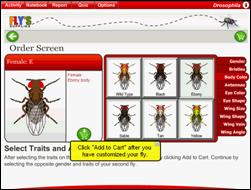 |
C |
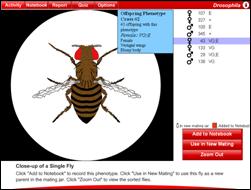 |
D |
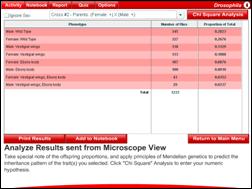 |
E |
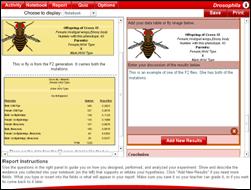 |
F |
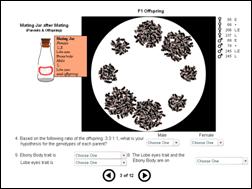
|
| |
Figure 2.
Views from the Drosophila activity: (A)
the laboratory bench showing the microscope,
incubator and computer, (B) the “fly store”
where students custom order flies for experiments, (C)
a view within the microscope of an offspring fly, (D)
a data table showing the results of an experiment, (E)
the report view showing a student’s laboratory notes
on the left side and the report they are writing on
the right side, and (F) one of the questions
in the interactive assessment quiz. |
Data analysis occurs in the
computer view (Fig. 2D). Data transferred from the
microscope appear in tabular form. Virtual Courseware uses
randomization algorithms that simulate experimental error
(Principle 6). Thus, no two students will obtain data that
are exactly the same. Students can propose a numerical
hypothesis for the expected ratio of the different fly
phenotypes and see how well their hypothesis matches the
data. A chi-square statistical analysis is also an option.
All data tables and analyses can be saved in the online
notebook (Principle 7).
Throughout the activity, images, data, and notes are added
into the notebook and can be viewed under the notebook tab
(Fig. 2E). Once the report is activated by the teacher,
the report tab guides the student in writing an online lab
st quiz, or highest score. All three
components (notebook, report, and quiz) are assessment
tools that can be used by the teacher (Principle 8). In
the options tab, the sounds, transitions, or the on-screen
directions for the activity can be turned off or on.
The
latest Virtual Courseware introduces a section for
instructors called the “teacher workspace” (Fig. 3). This
section permits teachers to create, customize, and manage
multiple and/or differentiated classes (Principle 9).
Teachers first register by completing a brief online form
for general demographic information. Teachers then use the
workspace to establish classes (Fig. 3A). Each class is
associated with a class code that the teacher shares with
their students. The students use the class code when they
set up their account thus giving the teacher access to
their assessment results. Teachers can create a set of
customized report templates (instructions to the student)
and associate the different report templates with
different classes (Fig 3B). Likewise, teachers can create
customized versions of the rubric they use to grade the
report and associate the different rubrics with different
classes (Fig 3C).
Through the assessment tab, the teacher can access student
and class results, allowing them to quickly gauge how well
the key concepts were understood (Fig 3D). Teachers can
also use the assessment tab to view student notebooks and
grade student reports using the associated rubric (Fig.
3E). The Teacher Workspace also provides access to a
printable teacher’s manual (Fig. 3F) that includes
instructions on using the activity with students,
suggested student assignments, and additional background
information for more advanced lessons (Principle 10).
Conclusion
Web-based simulations can be a convenient and effective
means of infusing more inquiry-based learning into the
science curriculum. When creating learning objects for
this purpose, care must be taken to address learning
standards, provide an engaging and open-ended learning
experience, reinforce scientific methodology and critical
thinking skills, and include opportunities for assessment.
The design principles recommended in this paper can help
achieve these goals.
Acknowledgements
This work was supported by a grant from the U.S. National
Science Foundation (ESI-0352529), the Chancellor’s Office
of the California State University System, and California
State University, Los Angeles.
References
Bybee, R. W. (1997). Achieving
Scientific Literacy: From Purposes to Practices. New
Hampshire: Heinemann.
Edelson, D. C. (1998).
Realising authentic science learning through the
adaptation of scientific practice. In B.J. Fraser and K.
G. Tobin (Eds.), International Handbook of Science
Education (pp. 317-331). Kluwer Academic Publishers, The
Netherlands.
Edelson, D. C., Gordin, D. N.
and Pea, R. D. (1999). Addressing the challenges of
inquiry-based learning through technology and curriculum
design. Journal of the Learning Sciences, 8(3&4),
391-450.
Flick, L. and Bell, R.
(2000). Preparing tomorrow's science teachers to use
technology: Guidelines for Science educators.
Contemporary Issues in Technology and Teacher Education
[Online serial],
1
(1). Available:
http://www.citejournal.org/vol1/iss1/currentissues/science/article1.htm
Herrington, J. and Oliver, R.
(2000). An instructional design framework for authentic
learning environments. Educational Technology Research and
Development, 48(3), 23-48.
Land, S. M. (2000). Cognitive
requirements for learning with open-ended learning
environments. Educational Technology Research and
Development, 48(3), 61-78.
Linn, M.C., Davis, E.A., and
Bell, P. (2004). Internet Environments for Science
Education. Mahwah, New Jersey: Lawrence Erlbaum
Associates.
National Research Council.
(1996). National Science Education Standards. Washington,
D.C.: National Academy Press.
National Research Council
(2000). Inquiry and the National Science Education
Standards: A Guide for Teaching and Learning. Washington,
D.C.: National Academy Press.
National Research Council.
(2001). Educating Teachers of Science, Mathematics, and
Technology. Washington, D.C: National Academy Press.
Pajo, K. and Wallace, C.
(2001). Barriers to the uptake of web-based technology by
university teachers. Journal of Distance Education, 16(1),
70-84.
Pellegrino, J., Chudowsky, N.,
and Glaser, R. (2001). Knowing what students know: The
Science and Design of Educational Assessment. Washington,
D.C.: National Academy Press.
Rogers, P. L. (2000). Barriers
to adopting emerging technologies in education. Journal of
Educational Computing Research, 22(4), 455-472.
Wiggins, G. P. and McTighe, J.
(2005). Understanding by Design. Alexandria, Virginia:
Association for Supervision and Curriculum Development.

Manuscript received 31 Aug
2006; revision received 8 Mar 2007.

This work is licensed
under a
Creative Commons
Attribution-NonCommercial-ShareAlike 2.5 License
|
